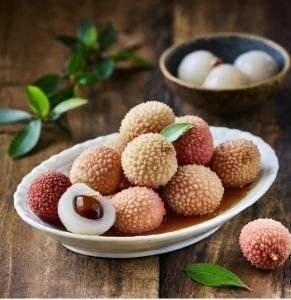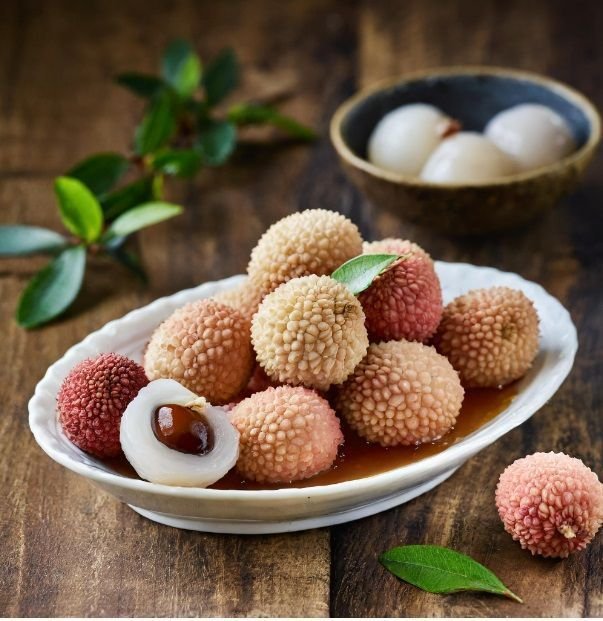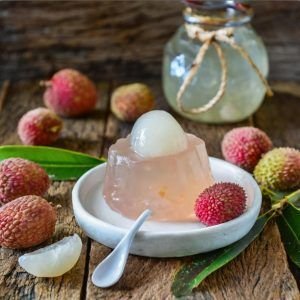Sweet and pungent fukienese lychee pork
Sweet and pungent fukienese lychee pork tenderlion
“Fujianese Lychee Pork” is a delightful dish that combines the sweetness of lychee fruit with the savory flavors of pork, creating a harmonious balance of tastes.
This dish originates from the Fujian province in southeastern China, where lychee trees flourish and pork is a staple ingredient in cuisine. The combination of sweet and pungent flavors characterizes many Fujianese dishes, reflecting the region’s culinary traditions of balancing contrasting flavors.
Recipe: Fujianese Lychee Pork
Ingredients:
- 500g pork tenderloin, thinly sliced
- 1 cup lychee fruits, peeled and pitted
- 3 cloves garlic, minced
- 1 onion, thinly sliced
- 1 red bell pepper, thinly sliced
- 3 tablespoons soy sauce
- 2 tablespoons rice vinegar
- 2 tablespoons ketchup
- 2 tablespoons honey
- 1 tablespoon cornstarch (mixed with 2 tablespoons water)
- 2 tablespoons vegetable oil
- Salt and pepper to taste
- Sesame seeds and chopped scallions for garnish (optional)
Instructions:
- Marinate the meat:
- In a bowl, combine the thinly sliced meat tenderloin with soy sauce, salt, and pepper. Mix well and let it marinate for at least 20-30 minutes.
- Prepare the Sauce:
- In another bowl, mix together the soy sauce, rice vinegar, ketchup, and honey to create the sweet and pungent sauce. Set aside.
- Cooking:
- Heat vegetable oil in a large skillet or wok over medium-high heat. Add minced garlic and sauté until fragrant, about 30 seconds.
- Add the marinated meat slices to the skillet and stir-fry until they are browned and cooked through, about 5-6 minutes. Remove the pork from the skillet and set aside.
- Stir-fry Vegetables:
- In the same skillet, add a bit more oil if needed. Stir-fry the sliced onion and red bell pepper until they are tender-crisp, about 2-3 minutes.
- Combining:
- Return the cooked meat to the skillet. Add the lychee fruits and pour the prepared sauce over the pork and vegetables. Stir well to combine.
- Thicken the Sauce:
- If desired, add the cornstarch mixture to the skillet to thicken the sauce. Stir continuously until the sauce thickens and coats the pork and vegetables evenly.
- Final Touch:
- Once the sauce has reached the desired consistency and everything is heated through, remove the skillet from the heat.
- Garnish and Serve:
- Garnish the Fujianese Lychee Pork with sesame seeds and chopped scallions for an extra burst of flavor and freshness.
- Serve hot with steamed rice or noodles.
Origin and Tradition:
The tradition of incorporating contrasting flavors like sweet and savory into Fujianese cuisine reflects the region’s rich culinary heritage. Fujian province is known for its abundant lychee orchards, where these fragrant and juicy fruits are widely enjoyed. Pork is a staple meat in Fujianese cooking, often featured in various dishes due to its versatility and availability.
This recipe exemplifies the region’s culinary philosophy of creating balanced and harmonious flavors. The sweetness of the fruit complements the savory pork, while the tangy sauce adds depth and complexity to the dish.
This recipe showcases the ingenuity and creativity of Fujianese cuisine, where simple ingredients are transformed into delectable dishes that delight the palate. Whether enjoyed at home or in a restaurant, Fujianese Lychee Pork is sure to impress with its unique blend of flavors and textures.

What is lychee
Lychee fruits, native to Southern China, are small, round fruits with a bumpy, red-pink shell that is easily peeled away to reveal juicy, translucent white flesh surrounding a single large seed. Known for their sweet and slightly floral flavor, lychees are popular in Asian cuisine, particularly in regions where they are grown, such as China, Taiwan, and Southeast Asia. Here’s more about lychee fruits and their usage in Asian dishes:
1. Fresh Consumption:
- In many Asian countries, lychees are enjoyed fresh as a snack or dessert. The sweet and refreshing flavor makes them a popular choice during the summer months.
2. Desserts:
- Lychees are commonly used in Asian desserts such as fruit salads, fruit cocktails, and sweet soups. They can be paired with other fruits like mangoes, pineapple, or oranges to create colorful and flavorful desserts.
3. Beverages:
- Lychees are used to flavor a variety of beverages, including juices, smoothies, teas, and cocktails. Lychee juice, in particular, is widely available in Asian markets and is often used as a base for mixed drinks.
4. Canned or Preserved:
- Canned lychees are convenient and widely available in supermarkets. They can be used in desserts, salads, or savory dishes. Lychees can also be preserved in syrup, retaining their sweetness and flavor for an extended period.
5. Savory Dishes:
- In addition to being used in desserts, lychees are sometimes incorporated into savory Asian dishes, especially in Chinese and Thai cuisines. They can add a touch of sweetness and texture to stir-fries, curries, and meat dishes.
6. Dim Sum:
- Lychees may occasionally be found in certain types of dim sum, such as dumplings or steamed buns, where they contribute both flavor and visual appeal.
7. Garnishes:
- Fresh lychees or lychee slices are often used as garnishes for desserts, drinks, and savory dishes, adding a decorative touch as well as a burst of sweetness.
Health Benefits:
- Lychees are not only delicious but also offer several health benefits. They are a good source of vitamin C, potassium, and dietary fiber.
- Vitamin C supports immune function and skin health, while potassium helps regulate blood pressure and heart function.
- The fiber content in this fruit promotes digestive health and may help prevent constipation.
Overall, these fruits are versatile and can be enjoyed in various forms, adding sweetness and flavor to a wide range of Asian dishes, beverages, and desserts. Whether eaten fresh, canned, or used as a flavoring agent, these fruits are a delightful addition to any culinary repertoire, providing both taste and nutritional benefits.

Lychee jelly – another amazing dessert
Ingredients:
- 2 cups lychee juice (freshly squeezed or canned)
- 1/2 cup granulated sugar (adjust to taste)
- 2 tablespoons agar-agar powder or gelatin powder
- 1/4 cup cold water
- Lychee fruits for garnish (optional)
Instructions:
1. Prepare the Lychee Juice:
- If using canned fruits, drain the syrup and reserve the fruits. Blend the fruits until smooth to make the juice. If using fresh fruits, remove the skin and seeds, then blend the fruit flesh with a little water until smooth. Strain the mixture to remove any solids, if desired.
2. Dissolve Sugar:
- In a saucepan, combine the fruit juice and granulated sugar. Heat the mixture over medium heat, stirring occasionally, until the sugar is completely dissolved.
3. Prepare the Agar-Agar or Gelatin:
- In a small bowl, combine the agar-agar powder or gelatin powder with 1/4 cup of cold water. Stir well to dissolve the powder completely. Let it sit for a few minutes to allow the powder to bloom.
4. Cook the Mixture:
- Once the sugar is dissolved in the fruit juice, add the agar-agar mixture or gelatin mixture to the saucepan. Stir well to combine.
5. Bring to a Boil:
- Increase the heat to medium-high and bring the fruit mixture to a gentle boil, stirring constantly. Allow it to boil for 1-2 minutes to ensure that the agar-agar or gelatin is fully dissolved.
6. Remove from Heat:
- Once the mixture has boiled for a couple of minutes, remove the saucepan from the heat. Stir the mixture for another minute to cool slightly.
7. Pour into Molds:
- Carefully pour the hot fruit jelly mixture into individual molds or a large mold, depending on your preference. You can use silicone molds, glass dishes, or any other containers that are suitable for setting jelly.
8. Cool and Set:
- Let the fruit jelly cool at room temperature for about 30 minutes, then transfer it to the refrigerator to chill and set completely. This process usually takes 2-3 hours, but it’s best to leave it in the fridge overnight for a firmer texture.
9. Serve:
- Once the fruit jelly is fully set, unmold it by running a knife around the edges of the mold and gently removing the jelly. Serve the fruit jelly on its own or with additional lychee fruits for garnish, if desired.
10. Enjoy:
- Serve the fruit jelly chilled and enjoy its sweet and refreshing flavor as a delightful dessert or snack.
Note:
- You can adjust the sweetness of the jelly by adding more or less sugar according to your taste preference.
- Agar-agar is a vegetarian alternative to gelatin and sets at room temperature, while gelatin sets when chilled. Adjust the quantity according to the instructions on the packaging for the desired consistency.
- Experiment with adding other fruits or flavors to the fruit jelly for variety, such as mango, coconut, or citrus fruits.





